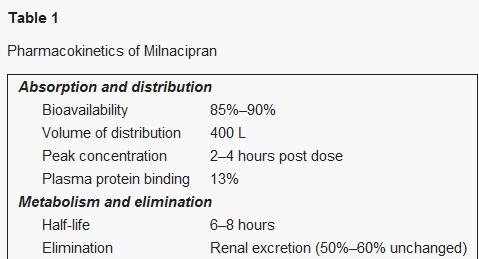The chemical name of milnacipran HCl is (±)-[1R(S),2S(R)]-2-(amino-methyl)-N,N-diethyl-1-phenylcyclopane-carboxamide HCl. Its empirical formula is C15H23ClN2O; the molecular weight is 282.8 g/mol. Milnacipran is a white to off-white crystalline powder with a melting point of 179° C. It is freely soluble in water, methanol, ethanol, chloroform, and methylene chloride and is sparingly soluble in diethyl ether.
Milnacipran savella is sold as orally administered, film-coated tablets in dosages of 12.5, 25, 50, and 100 mg of the active ingredient. It is also supplied in a dose-titration pack for patients starting treatment. According to the manufacturer, the tablets should be stored between 59°F and 86°F.
Milnacipran is a SNRI that inhibits the reuptake of both norepinephrine and serotonin; it also has a mild affinity for inhibiting N-methyl-D-aspartate (NMDA).5 Milnacipran exerts higher selectivity for norepinephrine reuptake than venlafaxine (Effexor generic price, Wyeth) or duloxetine.
The exact mechanism of milnacipran and its efficacy in FM are unknown, but it is hypothesized that the effects on regulating dysfunctional noradrenergic and serotonergic pathways contribute to its therapeutic properties. The selectivity for norepinephrine over serotonin has yet to show an overall clinical advantage, since both neurotransmitters have effects on pain modulation.
Milnacipran does not affect the reuptake of dopamine, and it has no significant affinity for serotonergic (5-HT1–7), dopaminergic (D1–5), opiate, benzodiazepine, and gamma-aminobutyric acid (GABA) receptors in vitro.
Because milnacipran lacks affinity for adrenergic, cholinergic, and histaminergic receptors, it does not exhibit many of the expected adverse effects (AEs) seen with the tricyclic antidepressants (TCAs). It has no significant affinity for Ca2+, K+, Na+, or Cl− channels, and it does not inhibit the activity of the monoamine oxidases (MAO-A and MAO-B) or acetylcholinesterase.
Absorption and Distribution
The pharmacokinetic properties of milnacipran are summarized in Table 1. Following oral administration, the drug is rapidly absorbed, exhibiting maximal concentrations at two to four hours and a mean peak concentration (Cmax) of 150 ng/mL after a single 50-mg dose. As a result of its favorable absorption profile, milnacipran exhibits high bioavailability of approximately 85% to 90%. First-pass elimination is limited, especially since there is low variability among subjects tested.10,11 Administration following a meal has no effect on peak plasma levels.
Table 1: Pharmacokinetics of Milnacipran

Milnacipran exhibits low, nonsaturable, plasma protein binding (13%), which is lower than the other approved SNRIs (venlafaxine and duloxetine). Because of its low protein binding, milnacipran is free to diffuse, and it is widely distributed in the body (5.3 ± 0.4 L/kg).
SHOP ELECTRONICS!!!
January 17, 2011 at 3:18 am
**YOUTUBE VIDEO REVIEWS ON THE HOTTEST ELECTRONICS OUT**…
#1 SITE FOR THE LATEST REVIEWS ON THE HOTTEST TECHNOLOGY HITTING THE MAINSTREAM!…